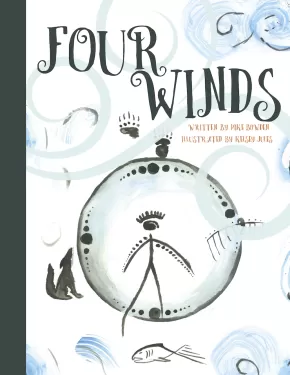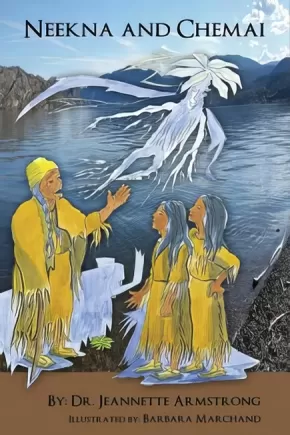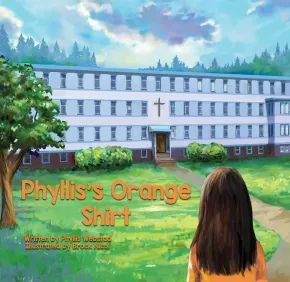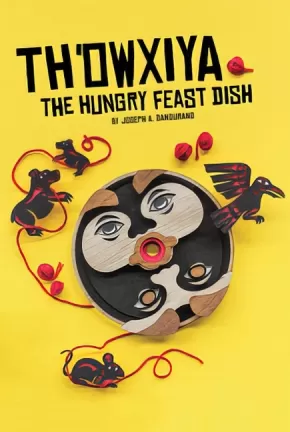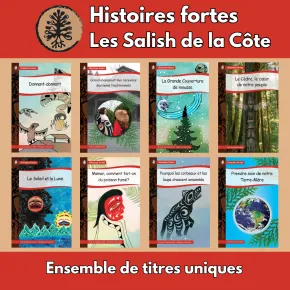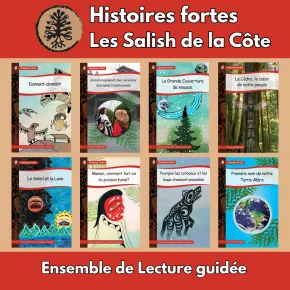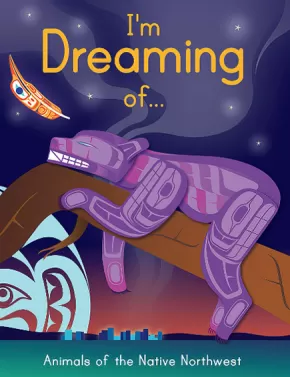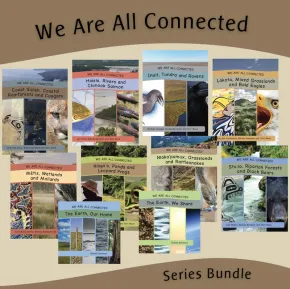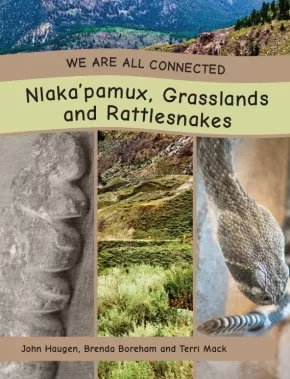
Salish
76
-
90
of
121 Results;
Sort By
Go To
of 9
Four Winds
 $18.50
$18.50

Artists:
Format:
Hardcover
Text Content Territories:
Indigenous Canadian; First Nations; Salish; Interior Salish; Secwepemc (Shuswap);
ISBN / Barcode: 9781771744478
Synopsis:
Synopsis:
A curious Qelmúcw (Person) from the Secwépemc Nation is learning about the world around him with the help of some of his relations. Sk̓elep (Coyote) and Tree guide Qelmúcw in understanding Cmesekst te Snewt (The Four Winds).
Qelmúcw experiences the power of a learning journey using perseverance and courage. He discovers that for meaningful learning to happen he needs to find balance or he could be blown off his learning journey, or even worse, not be completely open to his learning.
This story reflects the reciprocal learning and understanding relationship between a human being and all life and elements (all of relations). It models and reflects the importance of First Peoples’ Principles of Learning: learning is holistic, reflexive, experiential, and relational; learning involves the consequences of one’s actions; learning is embedded in story; and learning involves patience and time. Learning from Indigenous stories can be different and personal every time a story is read or told, depending on context.
Four Winds is the perfect bedtime story or read-aloud in the classroom.
This book works well alongside other books by Mike Bowden and Kelsey Jules, including Chief Goose and Porcupine, and includes a familiar character from Bear and Coyote.
Educator Information
Recommended for grades 3 to 7.
Recommended for grades 3 to 7.
This book is part of the Secwépemc Stories series.
This story is a great resource to introduce Indigenous languages to young readers. Secwepemctsín is one of 30 distinct Indigenous languages in British Columbia and is in the process of being revitalized after governments and religions developed policies to eliminate the rich language and culture of Indigenous peoples. The book integrates Secwépemc words into the text and includes a pronunciation guide on every page. The back of the book includes language resources and a link to an audio pronunciation guide for the Secwépemc alphabet.
This story connects to the BC First Peoples’ Principles of Learning and provides an opportunity for those reading to reflect, explore, connect, and learn on a personal interpretative level.
Curriculum links:
- Social emotional learning: community, helping others, critical thinking, learning from mistakes and trying again
- Reading and language skills
- Indigenous knowledge and traditions
Additional Information
32 Pages | 8.5 " x 11" | ISBN: 9781771744478 | Hardcover
32 Pages | 8.5 " x 11" | ISBN: 9781771744478 | Hardcover
If Instead of a Person
$14.00
Artists:
Format:
Paperback
Text Content Territories:
Indigenous Canadian; First Nations; Salish; Coast Salish;
ISBN / Barcode: 9780995012769
Synopsis:
Synopsis:
If Instead of a Person imaginatively explores the wisdom to be learned from living as a tree. Using child-friendly rhyming verse, Coast Salish author Courtney Defriend ponders a tree's steadfast connection and vital contribution to life on earth. Reinforced by Terra Mar's powerful illustrations, If Instead of a Person invites readers to become change agents that respect the interconnectedness of nature and humanity.
Educator Information
Partial proceeds go to Tillicum Lelum Aboriginal Friendship Centre.
Recommended for ages 4 to 10.
Juvenile Fiction, Indigenous Resource, Poetry, Environmental.
Additional Information
8.25" x 8.25"
La pirogue de Shin-chi
$12.95
Artists:
Format:
Paperback
Text Content Territories:
Indigenous Canadian;
ISBN / Barcode: 9782896118076
Synopsis:
Synopsis:
« Au bout du couloir, dans l’aile des petits garçons, Shin-chi était allongé dans son lit mais ne dormait pas. Il tenait précieusement sa petite pirogue dans la main. L’odeur parfumée du cèdre lui rappelait celle de son père. »Quand les Européens sont arrivés en Amérique, ils ont estimé que les Autochtones étaient des peuples non civilisés. Ils les ont chassés de leurs terres traditionnelles et les ont relégués dans des réserves. À la fin des années 1800, les gouvernements ont décidé de coloniser les enfants autochtones, de les forcer à s’adapter au mode de vie européen. Au Canada et aux États-Unis (mais également en Australie et en Nouvelle-Zélande), des lois furent adoptées obligeant les jeunes Autochtones à être éduqués dans des pensionnats autochtones.Dans ces établissements, les enfants apprenaient la culture, la religion et la langue des Européens. On leur donnait un nom européen. On leur enseignait le jardinage, l’agriculture et la menuiserie. On leur interdisait de parler à leurs parents ou à leurs frères et sœurs. Ils n’avaient pas non plus le droit de parler leur langue ni de pratiquer leurs coutumes. Certains enfants n’ont pu retourner chez eux qu’après de nombreuses années passées au pensionnat. D’autres n’y sont jamais retournés. Le Canada a compté environ 130 pensionnats indiens, et quelque 80 000 personnes vivant encore aujourd’hui y ont séjourné.
Educator Information
This book is available in English: Shin-chi's Canoe
Neekah's Knitting Needles
$21.95
Artists:
Format:
Hardcover
Text Content Territories:
Indigenous Canadian; First Nations; Salish; Coast Salish;
ISBN / Barcode: 9781550392555
Synopsis:
Synopsis:
Neekah is thrilled that she can finally learn to knit like her mother, grandmother, and great-grandmother before her. But knitting a toque for Grandma Dorothy is not as easy as she had imagined. A lyrical celebration of the tradition of Cowichan knitting among the Coast Salish peoples and the joy of creating something with your hands.
Neekah’s great-grandma, Mumma, knit all her life. Her Grandma Dorothy knits, her mom knits, and all her aunties knit. Even some of Neekah’s uncles knit. And Neekah wants to knit too. Every year she asks her mom if she can learn, and every year she hears, “Be patient. Your hands aren’t quite big enough yet.”
At last Neekah is ready to learn, her head and heart bursting with the colourful patterns and designs she will create with the wool. She sits down with her mom, holding the wooden needles Grandpa Carl has made for her and the wool from Auntie Joni’s wool shop. But knitting a toque for Grandma Dorothy is not as easy as she had imagined.
From award-winning author Sylvia Olsen comes a lyrical celebration of the tradition of Cowichan knitting among the Coast Salish peoples and the joy of creating something with your hands. Combined with Sheena Lott’s exquisite watercolours, families will love to share this cozy, loving story that carries the clicking of knitting needles down through the generations to a young girl holding her first set of needles.
Reviews
“This gentle and inspiring story—with outstanding illustrations—will be read over and over again. Love threads itself through the book as knowledge and skills are passed among generations: love of family, love of learning, love of tradition; plus perseverance, the joy of discovery, creativity, and the importance of patience. A simply wonderful book.” —Meg Swanson, Knitting designer, author, and owner of schoolhousepress
“Neekah’s Knitting Needles reminded me of my childhood and the great times I had with my grandfather, Xaniimastan (Peter Mitchell), sitting on his lap while he taught me cultural songs from the bighouse. I really enjoyed reading about a young person who wanted to learn and how knitting taught her our cultural lessons about never giving up and about Respect, Patience, Generosity, Hard Work, Love, and Caring. I was lifted up when I read how proud she was to give away her first toque.” —XanIImastan, TIm HarrIs, Stz’uminus First Nation Principal, W̱ SÁNEĆ Leadership Secondary School
Educator's Information
Recommended for ages 6 to 8.
Additional Information
8" x 10" | 40 Pages
Neekna and Chemai
$16.95
Artists:
Format:
Paperback
Text Content Territories:
Indigenous Canadian; First Nations; Salish; Interior Salish; Syilx (Okanagan);
ISBN / Barcode: 9781926886435
Synopsis:
Synopsis:
Neekna and Chemai are two little girls growing up in the Okanagan Valley in the time before European contact. Through these two friends, we learn about the seasonal life patterns of the Okanagan First Peoples. The girls spend time with Great-Grandmother, who tells them about important ceremonies, and they gather plants with Neekna's grandmother. Grandmother explains how bitterroot came to be an important food source, and why the people give a special ceremony of thanks at its harvest. Grandmother also tells the story of how a woman was changed to a rock to watch over the Okanagan Valley. Neekna understands how important it is that she has received the knowledge passed down for generations, from great-grandmother to grandmother to mother.
Educator Information
Recommended in the Canadian Indigenous Books for Schools 2019-2020 resource list as being useful for grades 2-7 in these subject areas: Career Education, English Language Arts, Social Studies.
Key Points:
- Learn about the seasonal life patterns of the Okanagan people.
- Armstrong's main goal in writing is to educate young people about Indigenous culture and history.
- Both educator and protector, Jeannette Armstrong is a professor of Indigenous Studies and a Canada Research Chair in Indigenous Philosophy. Her research into Indigenous philosophies and Okanagan Syilx thought and environmental ethics that are coded into Syilx literature has been recognized locally and globally, and she serves as an active member of the Okanagan Nation Alliance and the En’owkin Centre.
Additional Information
52 pages | 5.00" x 7.00" | 3rd Edition
Phyllis's Orange Shirt
$11.95
Artists:
Format:
Hardcover
Text Content Territories:
Indigenous Canadian; First Nations; Salish; Interior Salish; Secwepemc (Shuswap); Stswecem'c Xgat'tem;
ISBN / Barcode: 9781989122242
Synopsis:
Synopsis:
When Phyllis was a little girl she was excited to go to residential school for the first time. Her Granny bought her a bright orange shirt that she loved and she wore it to school for her first day. When she arrived at school her bright orange shirt was taken away. This is both Phyllis Webstad's true story and the story behind Orange Shirt Day which is a day for us all to reflect upon the treatment of First Nations people and the message that 'Every Child Matters'.
Educator Information
Phyllis's Orange Shirt is an adaptation of The Orange Shirt Story which was the best selling children's book in Canada for several weeks in September 2018. This true story also inspired the movement of Orange Shirt Day which could become a federal statutory holiday. A page of information about this day is included at the end of the book. A short author biography is also included.
Adapted for ages 4-6.
Recommended in the Canadian Indigenous Books for Schools 2020/2021 resource list for grades K-1 in the areas of English Language Arts and Social Studies.
This book is available in French: Le chandail orange de Phyllis
Additional Information
30 pages | 9.00" x 8.00"
Th'owxiya: The Hungry Feast Dish
$17.95
Format:
Paperback
Text Content Territories:
Indigenous Canadian; First Nations; Salish; Coast Salish; Sto:lo; Kwantlen;
ISBN / Barcode: 9780369100238
Synopsis:
Synopsis:
"Do not eat too much of the earth. Save some."
When you take something from the earth you must always give something back.
From the Kwantlen First Nation village of Squa’lets comes the tale of Th’owxiya, an old and powerful spirit that inhabits a feast dish of tempting, beautiful foods from around the world. But even surrounded by this delicious food, Th’owxiya herself craves only the taste of children. When she catches a hungry mouse named Kw’atel stealing a piece of cheese from her dish, she threatens to devour Kw’atel’s whole family, unless she can bring Th’owxiya two child spirits. Ignorant but desperate, Kw’atel sets out on an epic journey to fulfill the spirit’s demands. With the help of a sqeweqs, two spa:th, and a sasq’ets, Kw’atel endeavours to find gifts that would appease Th’owxiya and save her family.
Similar to “Hansel and Gretel” and the northwest First Nations story “The Wild Woman of the Woods,” Th’owxiya—which integrates masks, song, and dance—is a tale of understanding boundaries, being responsible for one’s actions, forgiving mistakes, and finding the courage to stand up for what’s right.
Reviews
“What makes Th’owxiya: The Hungry Feast Dish truly unforgettable is in its engaging story steeped in tradition.” —Mark Robins, Vancouver Presents
"This play about Th’owxiya, the basket ogress, allows students to engage with storytelling from his own Kwantlen perspective. This story includes several animal characters, including Kw’at’el (a mouse character) who must bring her some hungry children or his family will be eaten. With themes centering on Kwantlen language, culture, and relationships to the land, this play can engage a wide range of learners. This book also includes a Kwantlen terminology guide, links to pronunciation and language resources, and a teacher's resource guide which gives specific information on Dandurand’s own Kwantlen perspectives on storytelling." -Canadian Indigenous Books for Schools 2020/2021
Educator Information
Recommended theatre/play for young audiences ages 5 to 15 (96 pages, in a play/novel format).
For Kwantlen people, Th'owxiya is a mythological being used to teach children to listen and not to venture off alone lest she take them and eat them. Joseph began writing this play over twenty-five years ago, when he was an intern in a pilot program to study museology at the Canadian Museum of History.
Recommended in the Canadian Indigenous Books for Schools 2020/2021 resource list for Grades K to 6 in the areas of Drama, English Language Arts, and Music.
Additional Information
96 pages | 5.12" x 7.62"
Collection Histoires fortes - Les Salish de la Côte - ensemble de titres uniques
 $82.80 $92.00
$82.80 $92.00

Text Content Territories:
Indigenous Canadian; First Nations; Salish; Coast Salish; Indigenous American; Native American; Salish; Coast Salish;
ISBN / Barcode: 9781771745802
Synopsis:
Synopsis:
Cet ensemble comprend une copie de chaque titre dans la collection des Histoires fortes : Les Salish de la Côte (8 livres au total).
- Le Cèdre, le cœur de notre peuple
- Donnant-donnant
- La Grande Couverture de mousse
- Grand-maman et moi recevons des noms traditionnels
- Maman, comment fait-on du poisson fumé ?
- Pourquoi les corbeaux et les loups chassent ensemble
- Prendre soin de notre Terre-Mère
- Le soleil et la lune
Educator Information / Information pour éducateurs
Cette ressource est aussi disponible en anglais ICI.
Additional Information / Information additionnelle
ISBN: 9781771745802
Collection Histoires fortes - Les Salish de la Côte - ensemble pour la lecture guidée
 $496.80 $552.00
$496.80 $552.00

Text Content Territories:
Indigenous American; Native American; Salish; Coast Salish; Indigenous Canadian; First Nations; Salish; Coast Salish;
ISBN / Barcode: 9781771746823
Synopsis:
Synopsis:
Cet ensemble comprend 6 copies de chaque titre dans la collection des Histoires fortes : Les Salish de la Côte (48 livres au total).
- Le Cèdre, le cœur de notre peuple
- Donnant-donnant
- La Grande Couverture de mousse
- Grand-maman et moi recevons des noms traditionnels
- Maman, comment fait-on du poisson fumé ?
- Pourquoi les corbeaux et les loups chassent ensemble
- Prendre soin de notre Terre-Mère
- Le soleil et la lune
Educator Information / Information pour éducateurs
Cette ressource est aussi disponible en anglais ICI.
Additional Information / Information additionnelle
ISBN 9781771746823
The Orange Shirt Story
$19.99
Artists:
Format:
Paperback
Text Content Territories:
Indigenous Canadian; First Nations; Salish; Interior Salish; Secwepemc (Shuswap); Stswecem'c Xgat'tem;
ISBN / Barcode: 9780993869495
Synopsis:
Synopsis:
When Phyllis Webstad (nee Jack) turned six, she went to the residential school for the first time. On her first day at school, she wore a shiny orange shirt that her Granny had bought for her, but when she got to the school, it was taken away from her and never returned. This is the true story of Phyllis and her orange shirt. It is also the story of Orange Shirt Day (an important day of remembrance for First Nations and non First Nations Canadians).
Reviews
"The book includes a brief history of the Secwepemc people, St. Joseph’s Residential School, and a glossary and conversation starters. A must for elementary school teachers. " - Canadian Indigenous Books for Schools 2020/2021
Educator Information
Recommended for grades 2 to 5.
This resource is also available in French: The Orange Shirt Story (French) / L'histoire Du Chandail Orange
Recommended in the Canadian Indigenous Books for Schools 2020/2021 resource list for grades 1-5 in the areas of English Language Arts, Social Studies, and Career Education.
Additional Information
8.5" x 11" | 44 pages
A Day With Yayah
$21.95
Artists:
Format:
Hardcover
Text Content Territories:
Indigenous Canadian; First Nations; Salish; Interior Salish; Nlaka'pamux (Thompson);
ISBN / Barcode: 9781926890098
Synopsis:
Synopsis:
Set in the Okanagon, BC, a First Nations family goes on an outing to forage for herbs and mushrooms. Grandmother passes down her knowledge of plant life to her young grandchildren.
Reviews
"A Day With Yayah is a story sharing the special relationship that is built when a child learns from their Elders. It centers around an Indigenous family out on the land picking herbs and the Grandmother passing down her knowledge." - The Dalai Lama Center
Educator Information
Recommended for grades K-2 for the following subjects: Art Education, English Language Arts, Social Studies.
This resource offers a glimpse into the Nłeʔkepmx of the Nicola Valley in BC's Interior. A glossary of Nłeʔkepmxcin words appears at the back of the book.
Additional Information
32 pages | 9.25" x 10.25" | colour illustrations
I am Dreaming of... Animals of the Native Northwest (BB)
$12.00
Artists:
Format:
Board Book
Text Content Territories:
Indigenous Canadian; Indigenous American;
Grade Levels: Preschool; Kindergarten;
ISBN / Barcode: CBB20
Synopsis:
Synopsis:
I am Dreaming Of... is authored by Coast Salish, Musqueam artist Melaney Gleeson-Lyall.
Over 10 Northwest Coast Indigenous Artists have come together in I am Dreaming of... to create a bedtime story that rhymes. Dream your way through the forest as you encounter animals of the Pacific Northwest all drawn in beautiful coastal First Nations styles.
Additional Information
24 pages | 5.75" x 7.5"
We Are All Connected Series Bundle
 $179.55 $199.50
$179.55 $199.50

Text Content Territories:
Indigenous Canadian; First Nations; Salish; Coast Salish; Sto:lo; Interior Salish; Nlaka'pamux (Thompson); Nisga'a; Haisla (Kitamaat); Sioux; Lakota; Inuit; Métis;
ISBN / Barcode: 9781771745963
Synopsis:
Synopsis:
“We Are All Connected” is a series that explores how we all live together in a shared balance upon Mother Earth. Each book explores a specific ecosystem with a focus on one animal and its adaptations for survival within that ecosystem. Indigenous interviewees, each living within the same area, have responded to strategic questions as to how their community interacts with the land, their traditional territory. Explore each text with a sense of inquiry in mind.
8 We Are All Connected Titles Coast Salish, Coastal Rainforests and Cougars Haisla, Rivers and Chinook Salmon Inuit, Tundra and Ravens Lakota, Mixed Grasslands and Bald Eagles Métis, Wetlands and Mallards Nisga'a, Ponds and Leopard Frogs Nlaka'pamux, Grasslands and Rattlesnakes Sto:lo, Riparian Forests and Black Bears Each title covers the following curricular areas. Traditional storytelling and artwork begin each title from the focus Indigenous territory. Science: Biodiversity, classification, life cycles, food chains, food webs and connections between living and non-living things are just some of the science concepts included in each book. Social Studies: Contemporary and historical Indigenous cultural knowledge flows throughout each book. Local land forms, gatherings, harvesting practices and government are some of the social studies concepts included in each book.
2 Foundation Titles The two foundational books provide deeper understanding of the content of the “We Are All Connected” titles. We Are All Connected: The Earth, Our Home- explores biomes, ecosystems and biodiversity. We Are All Connected: The Earth, We Share- explores the interconnectedness between living and non-living things. View: We Are All Connected Learning Intentions
Additional Information
ISBN: 9781771745963
We Are All Connected: Coast Salish, Coastal Rainforests and Cougars
 $21.95
$21.95

Format:
Paperback
Text Content Territories:
Indigenous Canadian; First Nations; Salish; Coast Salish;
ISBN / Barcode: 9781771742504
Synopsis:
Synopsis:
“We Are All Connected” is a series that explores how we all live together in a shared balance upon Mother Earth. Each book explores a specific ecosystem with a focus on one animal and its adaptations for survival within that ecosystem. Indigenous interviewees, each living within the same area, have responded to strategic questions as to how their community interacts with the land, their traditional territory. Explore each text with a sense of inquiry in mind.
8 We Are All Connected Titles Coast Salish, Coastal Rainforests and Cougars Haisla, Rivers and Chinook Salmon Inuit, Tundra and Ravens Lakota, Mixed Grasslands and Bald Eagles Métis, Wetlands and Mallards Nisga'a, Ponds and Leopard Frogs Nlaka'pamux, Grasslands and Rattlesnakes Sto:lo, Riparian Forests and Black Bears Each title covers the following curricular areas. Traditional storytelling and artwork begin each title from the focus Indigenous territory. Science: Biodiversity, classification, life cycles, food chains, food webs and connections between living and non-living things are just some of the science concepts included in each book. Social Studies: Contemporary and historical Indigenous cultural knowledge flows throughout each book. Local land forms, gatherings, harvesting practices and government are some of the social studies concepts included in each book.
2 Foundation Titles The two foundational books provide deeper understanding of the content of the “We Are All Connected” titles. We Are All Connected: The Earth, Our Home- explores biomes, ecosystems and biodiversity. We Are All Connected: The Earth, We Share- explores the interconnectedness between living and non-living things.
Authenticity Note: This work contains some Indigenous artwork and photographs from Celestine Aleck.
Additional Information
32 pages | 8.50" x 11.00" | IBSN: 9781771742504
We Are All Connected: Nlaka'pamux, Dry Grasslands and Rattlesnakes
 $21.95
$21.95

Format:
Paperback
Text Content Territories:
Indigenous Canadian; First Nations; Salish; Interior Salish; Nlaka'pamux (Thompson);
ISBN / Barcode: 9781771742528
Synopsis:
Synopsis:
“We Are All Connected” is a series that explores how we all live together in a shared balance upon Mother Earth. Each book explores a specific ecosystem with a focus on one animal and its adaptations for survival within that ecosystem. Indigenous interviewees, each living within the same area, have responded to strategic questions as to how their community interacts with the land, their traditional territory. Explore each text with a sense of inquiry in mind.
8 We Are All Connected Titles Coast Salish, Coastal Rainforests and Cougars Haisla, Rivers and Chinook Salmon Inuit, Tundra and Ravens Lakota, Mixed Grasslands and Bald Eagles Métis, Wetlands and Mallards Nisga'a, Ponds and Leopard Frogs Nlaka'pamux, Grasslands and Rattlesnakes Sto:lo, Riparian Forests and Black Bears Each title covers the following curricular areas. Traditional storytelling and artwork begin each title from the focus Indigenous territory. Science: Biodiversity, classification, life cycles, food chains, food webs and connections between living and non-living things are just some of the science concepts included in each book. Social Studies: Contemporary and historical Indigenous cultural knowledge flows throughout each book. Local land forms, gatherings, harvesting practices and government are some of the social studies concepts included in each book.
2 Foundation Titles The two foundational books provide deeper understanding of the content of the “We Are All Connected” titles. We Are All Connected: The Earth, Our Home- explores biomes, ecosystems and biodiversity. We Are All Connected: The Earth, We Share- explores the interconnectedness between living and non-living things.
Authenticity Note: This title includes some authentic Indigenous photographs.
Additional Information
32 pages | 8.50" x 11.00" | ISBN: 9781771742528
Sort By
Go To
of 9

